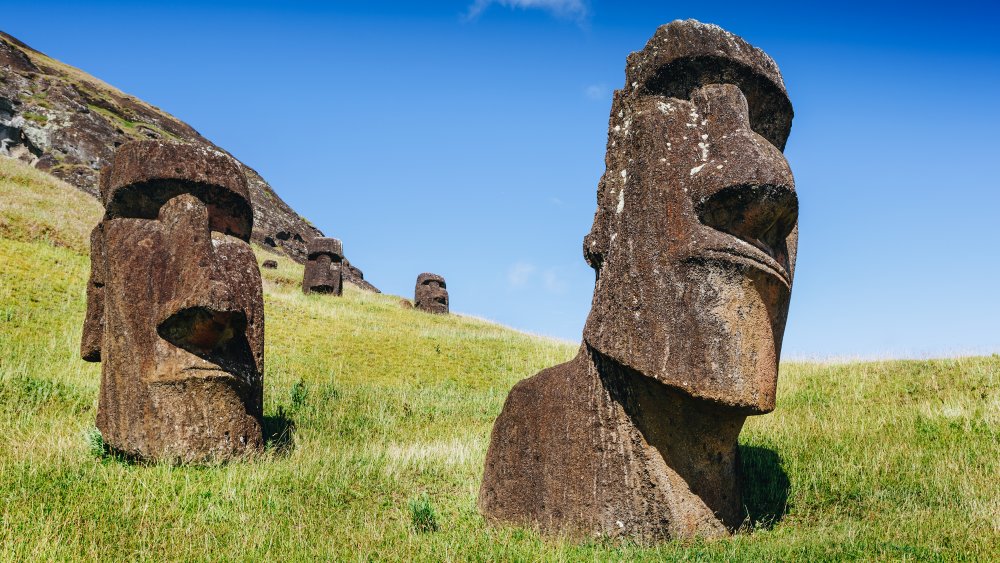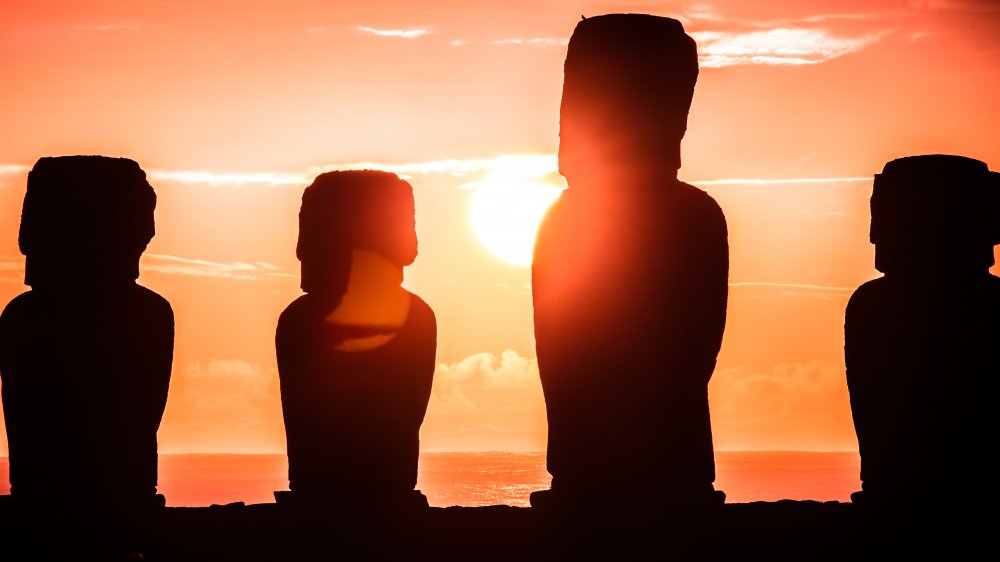The Real Reason The Easter Island Civilization Collapsed
Everybody's gotta be somewhere. And Easter Island, the land of those incredibly impressive stone heads jutting out of the soil, pushes the limits on the assertion: almost smack-dab halfway between Chile (2,300 miles to the east) and Tahiti (2,500 miles to the west). In May 2020 Scientific American reported that Easter's nearest neighbor is actually Pitcairn Island, where the Bounty mutineers ended up, 1,200 miles to the northwest. (And they chose Pitcairn because it was barely anywhere.)
As near as the science can determine, human beings have been inhabiting Easter Island since somewhere around 400-700 CE. The first arrivals, voyagers from Polynesia, named the 64 square miles Rapa Nui, says History. The people thrived, were fruitful, and multiplied. And they erected the stone figures, called moai, says CNN — nearly 1,000 of them, the largest at 70 feet tall, solid stone. Clearly they were a people who could work together. They had sufficient food and energy and time to devote to large works of art.
Rapa Nui is a long way from anywhere else
The first Europeans to encounter the civilization of Rapa Nui were Dutch explorers who bestowed "Easter" on the island, marking the day they arrived in 1722. Captain James Cook arrived in 1774, and found a denuded landscape and a decimated population — a few hundred, down from thousands in the island's heyday. What happened?
One of the more popular theories has suggested a collapse of the island's human civilization because of infighting and environmental devastation. The "collapse" theory says that the islanders basically used up their resources faster than they could be replaced. That was coupled with warfare among factions living there. Loss of trees meant loss of habitat and an increasingly harsh environment, coupled with death inflicted upon one another.
Other theories have been advanced in the last couple of years. As NPR reported in 2013, two anthropologists from the University of Hawaii suggest that the population became compromised when European rats were introduced to the environment. The islanders didn't burn off their forests in an ill-advised bid to clear land; the rats, with no natural enemies and a taste for tree seeds and sprouts, destroyed them. When the trees went, so did wildlife. The people adapted — the population shrank, but it didn't disappear.
You dirty rats? Maybe
In 2018, CNN related the work of archaeologist Dale Simpson of the University of Queensland. It is Simpson's contention that the people did not fall upon one another, waging a mutual genocidal campaign. It's his contention that the people of Rapa Nui were cooperative before, during, and after the environmental collapse the island suffered. He also admits that the commonality of tools and their sources might indicate coercion, rather than cooperation. And more study is needed.
Scientific American tells another hypothesis. Robert DiNapoli, a doctoral student from the University of Oregon, has gathered evidence that the real collapse of the island's civilization came after that fateful meet-and-greet with Europeans, ushering in "a period characterized by disease, murder, slave raiding, and other conflicts."
The popular narrative that the islanders were their own worst enemies is being challenged repeatedly. Chief among the observations is that the Rapa Nui culture didn't actually disappear. Said Napoli: "The degree to which their cultural heritage was passed on — and is still present today through language, arts, and cultural practices — is quite notable and impressive. This degree of resilience has been overlooked due to the collapse narrative and deserves recognition." As we stand in awe of those magnificent moai.


